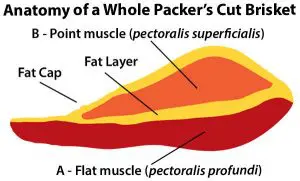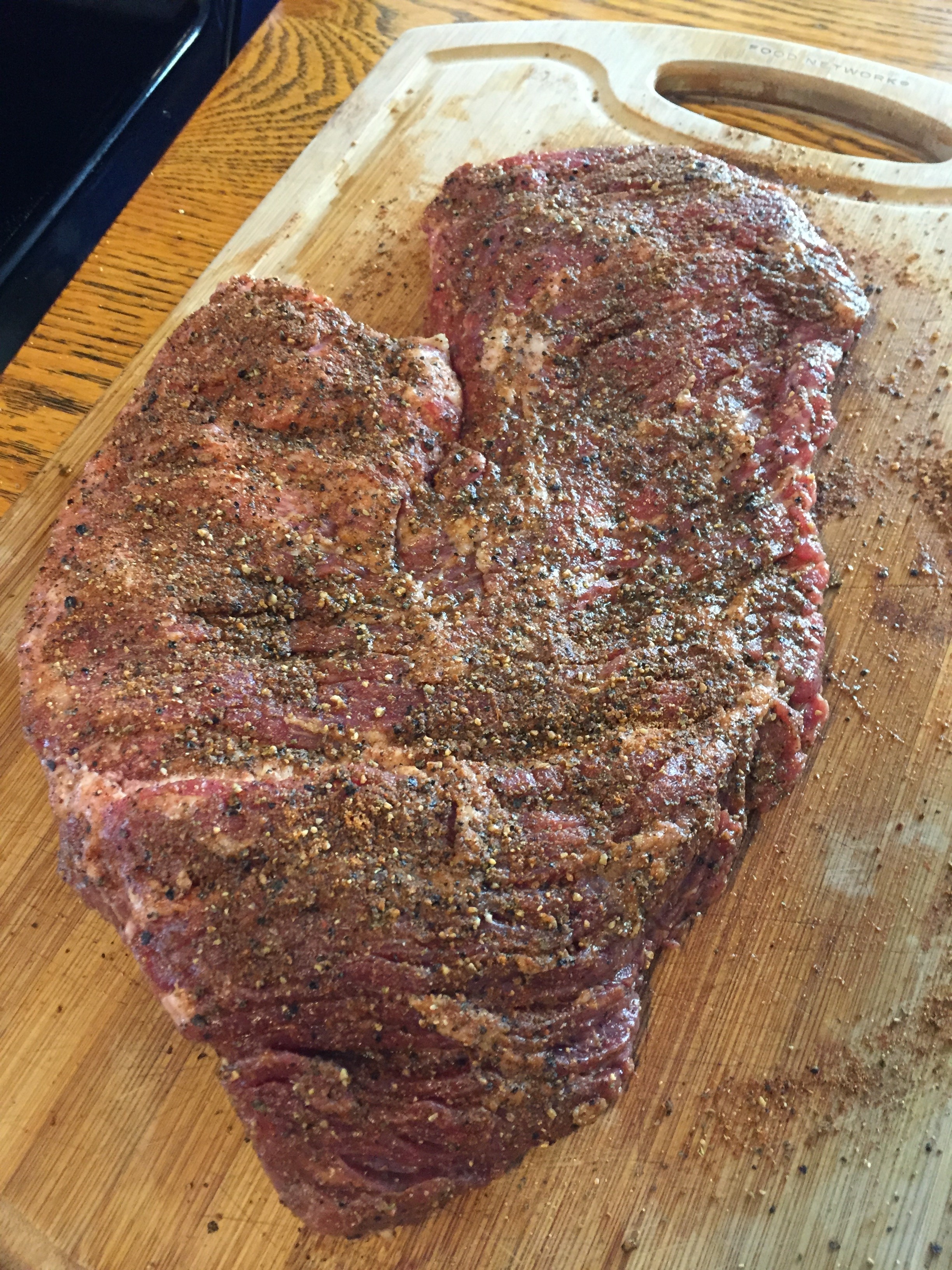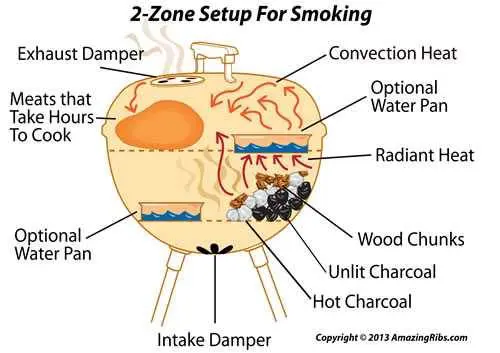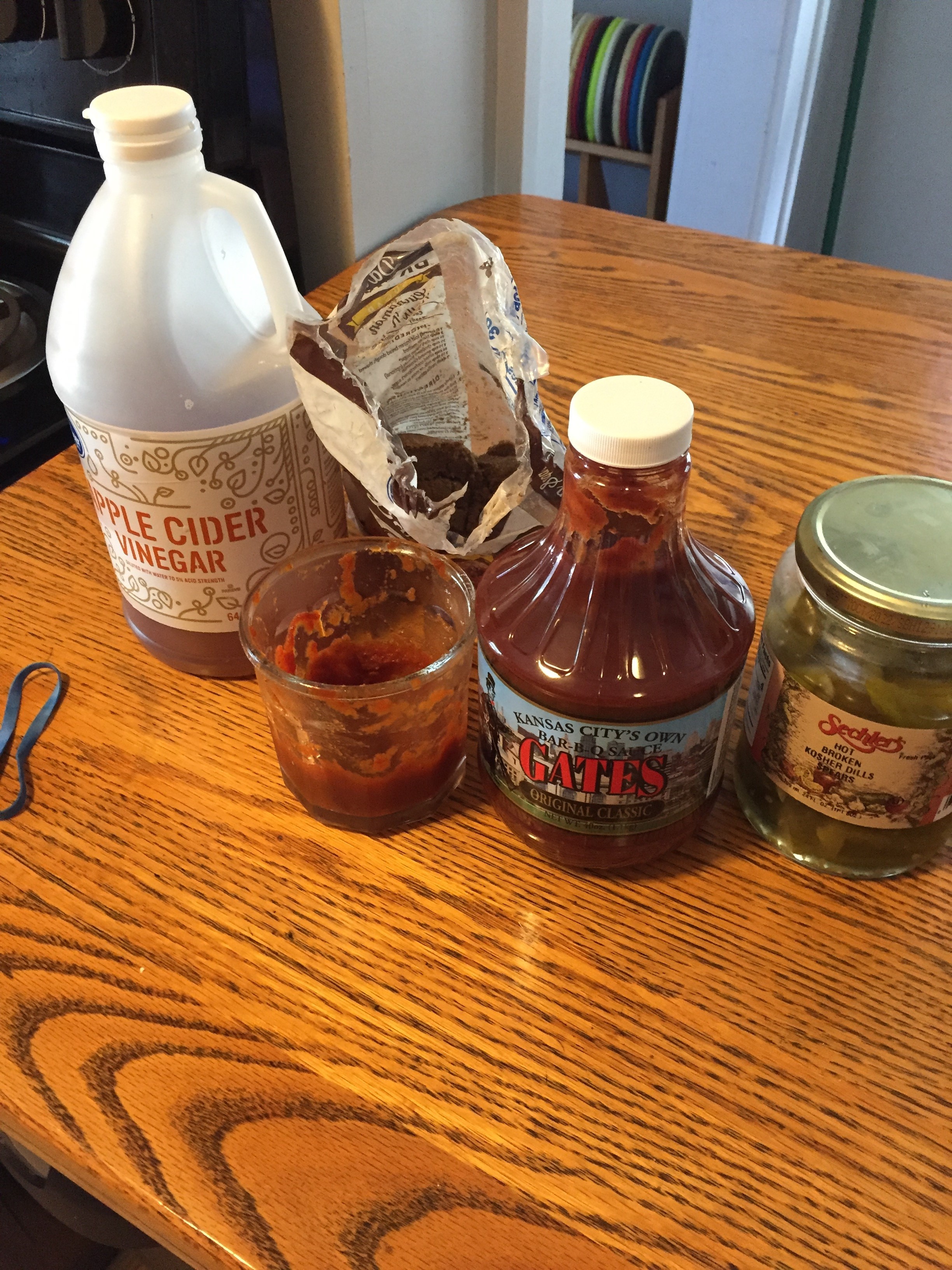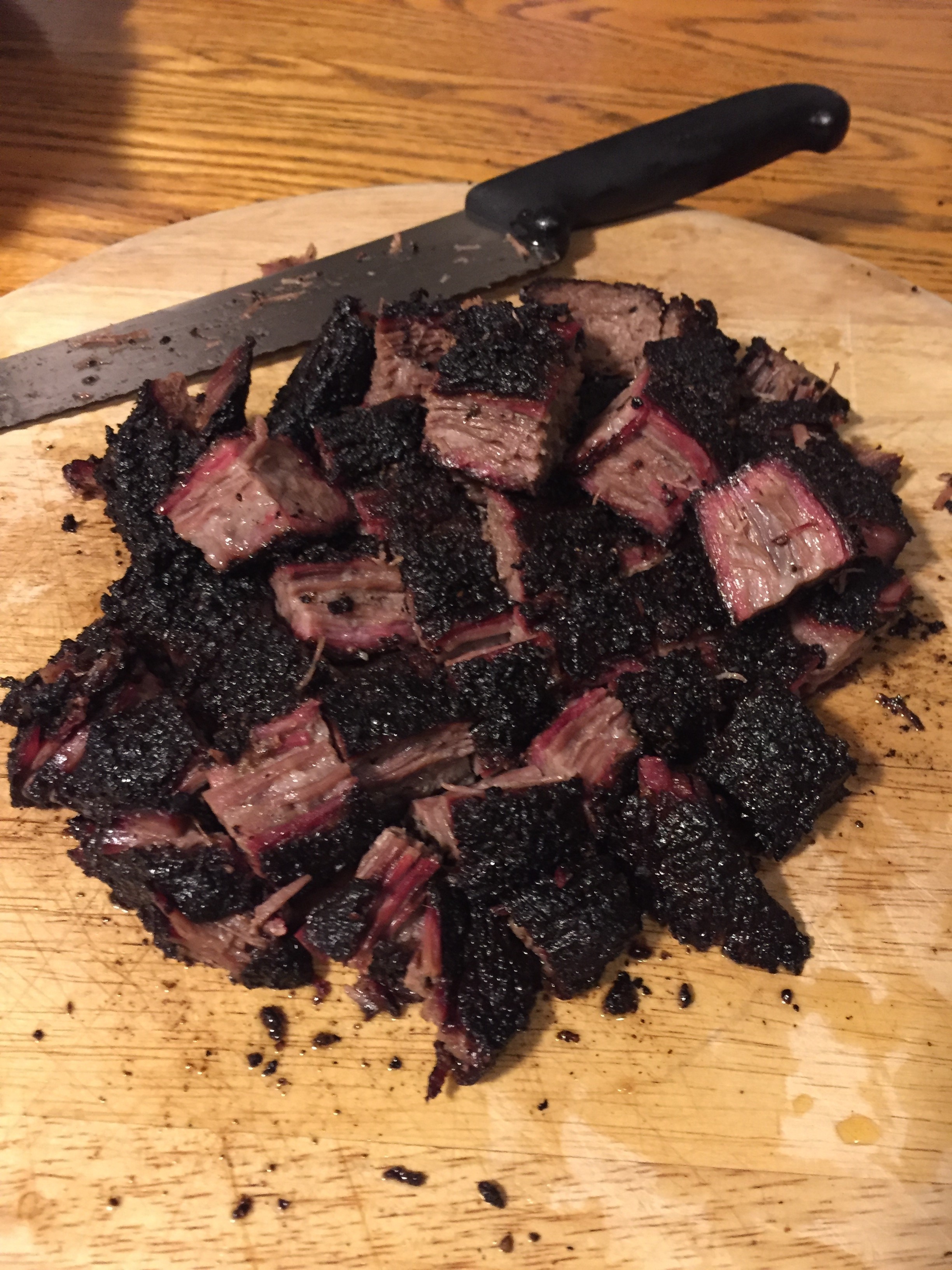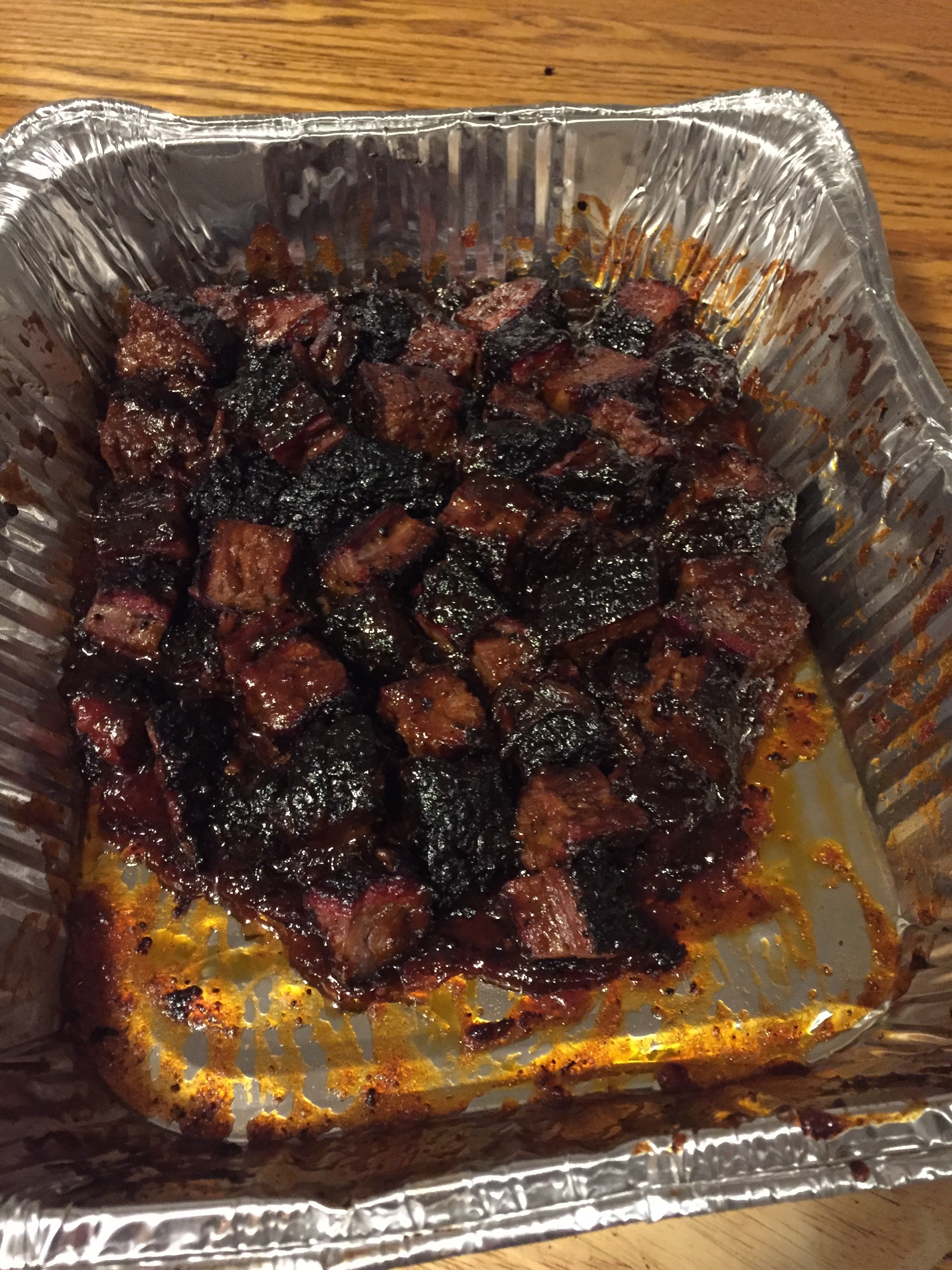Gah- this thread is done, content-wise.
How 'bout one last death rattle?
Backstory: Had a brisket point* in the freezer that reminded me recently that it needed eatin', so I made Burnt Ends. Read on for play-by-play commentary plus some pictures that I sent to my mom.
*
The brisket cut is actually two muscles, the flat (aka the "lean" in counter-serve BBQ speak) and the point (aka the "fatty" or the "moist").
The point has a whole lotta intramuscular fat (or "marbling"), so I trimmed up most all of the surface fat. Laying the muscle fibers pretty bare like this yields more crust (or "bark"), but the trade-off is that the meat is made more vulnerable to the fire (plus fat is flavor, right?). On a whim, I saved the strips of trimmed fat in a Ziploc. After trimming, I added a good layer of coarse salt and let it rest in the fridge for a few hours so that the salt had enough time to begin that magic, osmotic march inward.
For the rub, I went pepper heavy - lots of black peppercorns, paprika, some dried chiles that I had forgotten about in the back of the spice cabinet, few dashes of cayenne. Paprika helps develop that deep, mahogany color characteristic of BBQ-d meats. Also added celery seed (high nitrate content) to help with smoke ring formation. I was feelin' frisky, so I ground up a little rosemary, too. Here she is all rubbed up (rather, all "patted" up):
With the rub on, I got my BBQ-makin' device, a classic 22-in. black Weber Kettle, fired up. To make delicious, smoked BBQ meats on a Kettle, you've got to set it up for two-zone cooking, which really just means having a hot side and a less hot side in the cooker. On the hot side, I used blue-bag briquettes and buried a couple chunks of oak in the coals. Here's a pretty good infographic on how to set up a Kettle or similar for two-zone cooking:
While my "pit" warmed up, I made a finishing sauce for the Ends. About 3 parts OG Gate's BBQ sauce, 1 part brown sugar (high sugar content is good for glazin'), 1 part homemade ketchup, plus a little added acidity (few shakes of apple cider vinegar & hot pickle juice). After tasting, I thought it needed some more savory notes, so I cut up half an onion in big slices & halved a garlic clove, which I added to the sauce & let simmer for ~ half an hour before container-ing and store-ing in the fridge.
Once the pit stabilized at ~ 300 d.F., I placed the point on the side opposite the fire and beneath the exhaust (so that the heated air travels from the fire and over the meat before exiting the pit stage left). Some folks don't think you should BBQ meat at higher temps like for example 300 d.F., but they're wrong. For my Ends, I wanted to maximize the Maillard reaction, spice-infused goodness of the bark. In other words, I like my Ends like I like my woods: lovely, dark and deep.
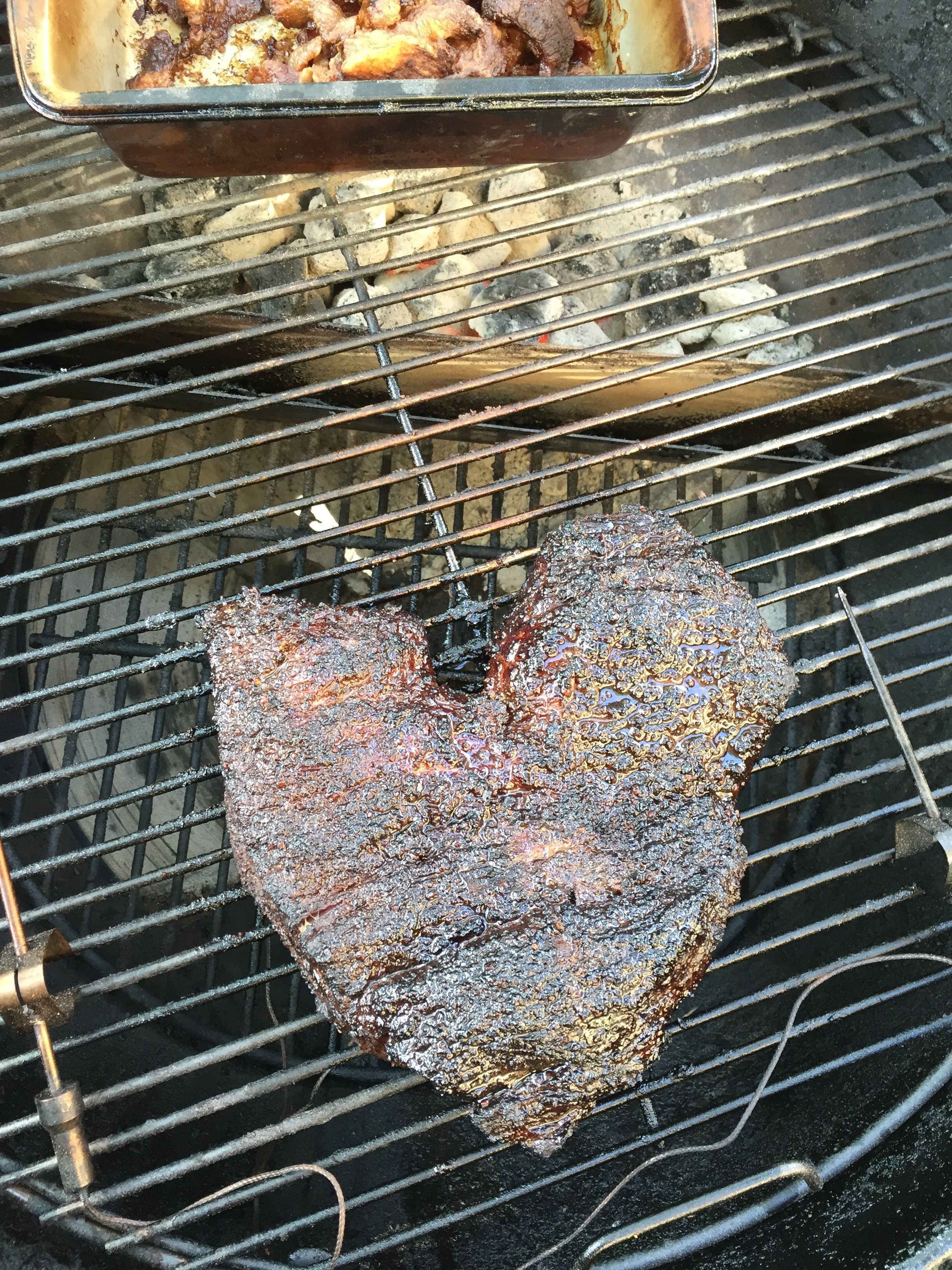
That was at about 5-6 hours on the pit, and about the color that I wanted to achieve before wrapping with foil (aka the "Texas Crutch", or you can also wrap in pink butcher paper for a "Franklin Crutch"). The pit ran between 300 and 275 d.F. during the cook. I used a water pan to help with humidity, and I put the fat trimmings that I saved in an old bread pan to render & liquefy. Instead of spraying the meat with water or apple juice like I usually do, I basted the brisket with the rendered fat several times during the cook. I also poured some in the foil for the Texas Crutch. Wrapping your BBQ meat during the last part of the cook helps with moisture content (plus it can speed up the cooking process by combating the stall or meat sweats), but the trade off is that it can weaken your bark. Some folks think that you should never wrap your meat, that it is in-authentico, but they're wrong:
"The first time man roasted meat over fire, the carcass was probably wrapped and steamed. Not in banana leaves for pork lau lau, or corn husks for chicken tamales. But steaming in its own natural hide."
https://genuineideas.com/ArticlesIndex/thecrutch.html
So, once the meat had developed the desired color & surface texture, I double wrapped it in foil with some added fat and placed in the oven at ~ 250 d.F., with a thermometer probe in the thickest part. Some folks don't think you should finish BBQ meat in the oven, but they're wrong. After a certain point in the cook, it's just a BTUs game.
Once the probe read ~ 195 d.F., I started checking for doneness every ~ 15 minutes or so by poking with the nub of a plastic fork (plus a semi-fancy-pants ThermoWorks instant-read pen thermometer). Brisket doneness is more of a feel thing than a specific temperature thing, which can be a tough concept for new BBQ-ers to grasp. You want a toothpick or bamboo skewer or plasticware nub or Thermapen to move through the meat as if it were peanut butter or semi-soft butter. You also want the meat to jiggle. This happened at about ~206 d.F. internal for this particular point.
I let the steam out of the foil and let the meat rest for about half an hour before cubing it into little meat candies:
The Ends were then tossed with the sauce made earlier (and warmed-in-the-microwave) plus the last of the rendered brisket fat, and put back on the pit for about 15 minutes until the sauce had set, or until they looked lovely, dark and deep.
Served late last night with stale sesame buns, frozen tater tots and canned beans.
Bonus content:
Here's writer (and Kansas Citian) Calvin Trillin's myth-making bit about Bryant's Burnt Ends in an 1972 article published in Playboy Magazine:
"The main course at Bryant's, as far as I'm concerned, is something that is given away for free -- the burned edges of the brisket. The counterman just pushes them over to the side as he slices the beef, and anyone who wants them helps himself. I dream of those burned edges. Sometimes, when I'm in some awful overpriced restaurant in some strange town -- all of my restaurant-finding techniques having failed, so that I'm left to choke down something that costs seven dollars and tastes like a medium-rare sponge -- a blank look comes over my face: I have just realized that at that very moment someone in Kansas City is being given those burned edges free."
